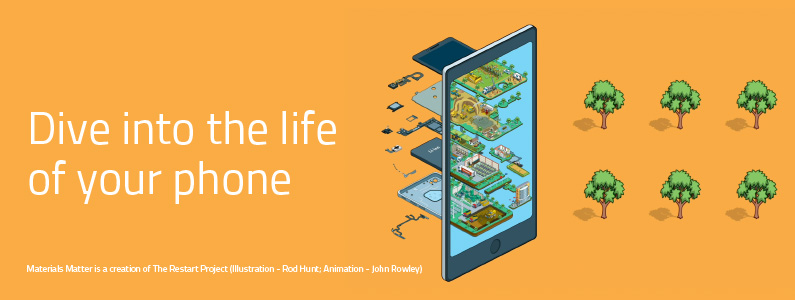Explore the secret life of your phone
The Materials Matter initiative, creation of the Restart project – supported by the EIT RawMaterials Academy, REPLAY and Refer projects, and a number of museums across Europe, Materials Matter provides a space for education and awareness on the entire lifecycle of a mobile phone. The initiative is perfect for 8-12-year-olds and everyone who wants to learn about raw materials for modern life.
Your phone is with you for a few years of your life, but did you know it had already experienced a lot before it reached you? Equally, after you stop using it, your phone’s story is far from over. The lifecycle of your phone has big impacts on the planet. Your phone contains raw materials – the minerals and metals inside. But where do these raw materials come from? And what happens when you recycle your phone?
Your phone consists of many different materials that have one thing in common: they are mined from the earth.
Minerals, metals and advanced materials are essential for modern technologies. Did you know there are more than 40 different materials in a smartphone? Each material has its own complex supply chain. Often, the minerals used to produce components for your phone, like the battery, are mined outside of Europe. Currently, Europe is highly dependent on the supply of minerals and metals coming from developing and emerging countries. Some materials for your phone come from politically unstable countries with limited environmental and workers health and safety regulations.
This is why the CERA, innovation project, supported by EIT RawMaterials, is developing a certification process for raw materials to ensure the materials we need for modern technologies are sourced through a sustainable value chain.
All the materials go through a long supply chain to get into your phone, from mineral exploration and mining tomineral processing. At the design step, it is important to consider the global efforts to transition to a circular economy. A circular design concept of a new product can help prolong the life of a mobile phone, which means it can be easily repaired or remanufactured. When you consider buying a new phone, check whether it can be repaired and where you can recycle your old device.
Some day, your phone might break and cannot be repaired. Then it becomes electronic waste.
Waste Electrical and Electronic Equipment (WEEE) or e-waste, includes computers, TVsets, fridges, and mobile phones. It is basically any old, discarded, or no longer in use electrical or electronic equipment that requires a power source, either electric or battery/accumulator power.
According to the Global E-waste Monitor (2020), approximately 53.6 million tonnes of e-waste were generated in 2019. It is estimated that the amount of e-waste generated will exceed 74 million tonnes in 2030. Thus, the global quantity of e-waste is increasing at an alarming rate of almost 2 million tonnes per year. But there is something you can do!
Recycling can help us extract some of the raw materials from a broken phone. These materials can then be used again.
There is good news: the recycling rates for materials in batteries are increasing. That means that we are able to extract a larger proportion of the raw materials in order to reuse them.
Recycling electronic devices to extract the raw materials is a difficult process. It takes a lot of energy and complicated work. Companies around the world are inventing new and simpler recycling processes to recycle phone batteries.
To help our planet, we encourage you to check the WEEE4Future project. You can use an e-waste calculator to discover which appliance materials can be recycled and the potential emissions saved. And if you live in Germany, Italy, Ireland or Slovenia, you can check for e-waste collection points near your home to recycle your old devices and give the valuable materials in your phone a second life!




